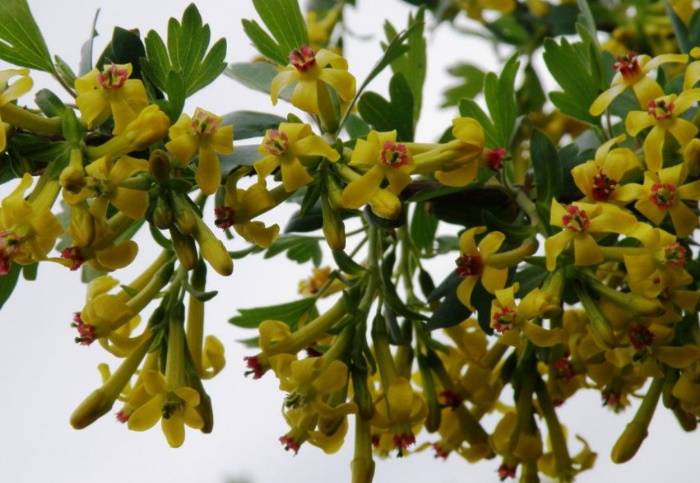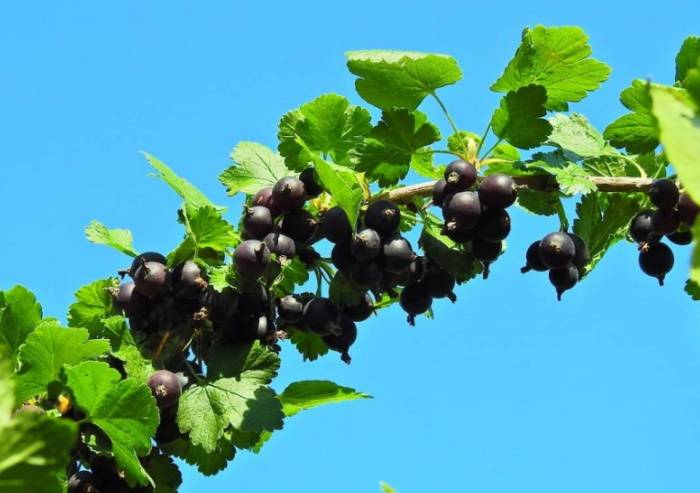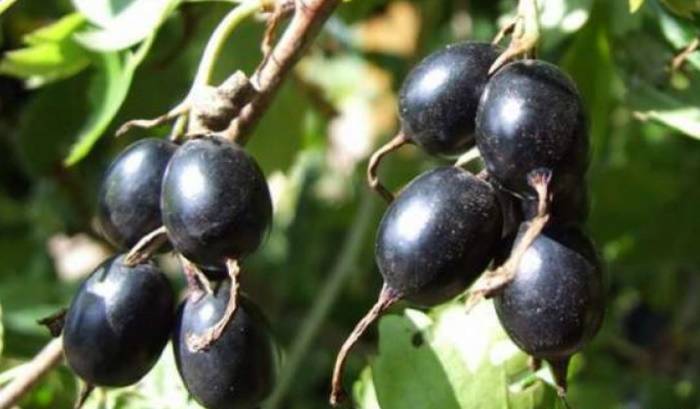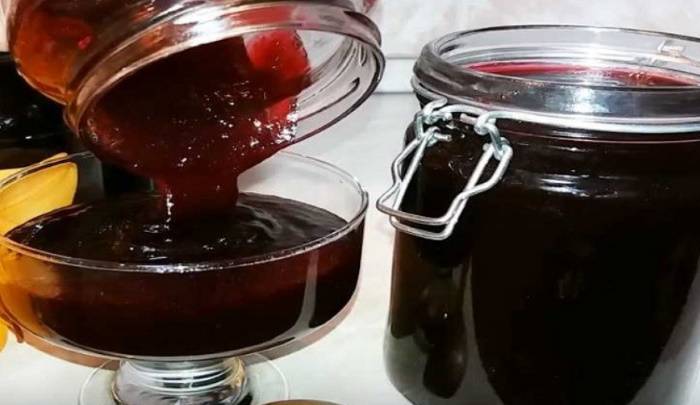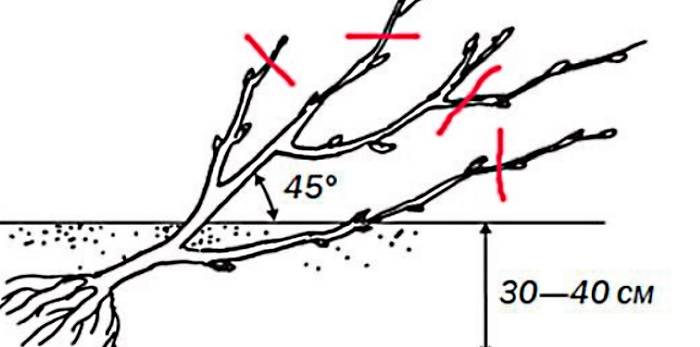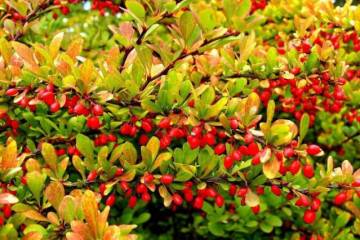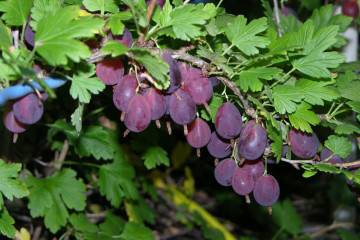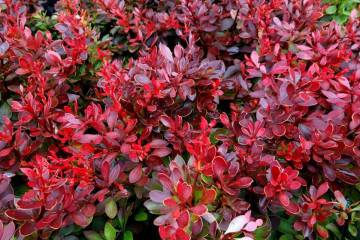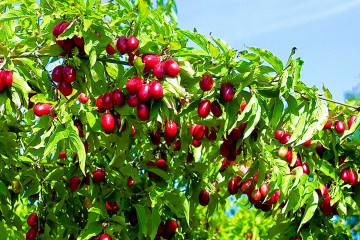A hybrid of currants and gooseberries - planting and caring for yoshta
Content:
Hybrid fruits are often called compound names. From some of them, it is difficult to guess which plants were involved in the crossing. For example, a sharafuga is plums plus apricot and peach. Understanding what a gooseberry-currant hybrid can be called is also not easy, and it got its name "Josta" from the German designations for black currant JOhannisbeere and gooseberry STAchelbeere (gooseberry).
Description of the hybrid
The main goal of the breeding work was to create berries with the taste and useful qualities of black currant and gooseberry, but without thorns. They began to cross the plants at the beginning of the 20th century, but only in the 80s were sufficiently productive hybrids obtained, which were capable of reproduction by shoots and cuttings.
Flowering begins in mid-April, berries ripen in mid-July. A hybrid of currants and gooseberries is a sprawling, unpretentious berry shrub that reaches a height of 2-2.5 m and has the properties of both parent plants.
During the flowering period, yoshta has a beautiful appearance and can be grown as an ornamental plant. Although the main purpose of Josta is to harvest vitamin fruits, which are eaten raw, canned, candied, dried.
Yoshta is an intensively developing perennial plant, a mixture of various types of gooseberries and currants. It can live in one place for up to 25-30 years. The root system of shrubs is located in the surface layers of the soil at a depth of no more than 40 cm. Leaves of a dark green hue resemble currant leaves, but do not have its smell. Ripe sweet and sour fruits are covered with a dense skin, have a black color and are collected in a cluster of 3 or more berries. The average weight of the berries is about 5 g.
Gooseberries crossed with currants, as they are called in different countries
The German name Josta for the plant stuck in honor of Rudolf Bauer, a breeder from Germany, who has been working on the creation of a hybrid for several decades. In addition to him, they worked on the crossing of various varieties of gooseberries and black currants in America, Sweden, England, the USSR, and Russia. In the English-speaking segment, yoshta is called Jostaberry.
Popular varieties of yoshta
Different types of yoshta have many common characteristics, but differ significantly in the shape and size of the bush, weight and taste of the fruit, as well as yield and frost resistance.
EMB grade
The crowns of bushes of the English variety called EMB can grow up to 2 meters wide. The branches of the shrub grow up to 1.5 m in height, and do not need a garter. The leaves are shaped like currant leaves. The berries have a sour taste, weighing up to 12 g, yield up to 10 kg per bush.
Crown
The Crohn variety has been created in Switzerland. This plant is a cross between white, black currant and gooseberry. A short, erect bush with thick branches resembles a tree, the leaves are gooseberry. The yield of the hybrid is average. No more than 2-3 kg of berries weighing up to 7 g are removed from one plant. At the beginning of ripening, the fruits taste like gooseberries, ripe berries acquire the taste of currants.
Krondal
The American hybrid Krondal is named after its creator, the Krondal breeder. This hybrid is a golden currant crossed with a gooseberry. Leaves are currant. Fruits are black in color, oval, reminiscent of gooseberries, but have a currant flavor.
In a temperate climate, the plant is low-yielding, freezes out in severe frosts. In order for the bushes of the Krondal hybrid to bear fruit well, it is necessary to grow parent plants next to them.
Rext
The bushes of the Russian variety Rekst are used to form vegetable hedges, although up to 10 kg of fruit can be harvested from each. The berries of the variety are oval in shape, have a currant flavor and a sweet taste, weigh about 4 g, the leaves are in the form of gooseberry leaves.
The soviet-bred kryzha currant is called a hybrid of T. S. Zvyagina, although other breeders also took part in its creation, in particular Kalabshkina T. S. Excellent jams, jellies, compotes are obtained from the berries. Fruits contain a lot of sugars, bushes perfectly reproduce by shoots.
Yohini
Yoshta Yohini has white inflorescences, gooseberry leaves. After flowering, dark blue round berries are formed. Ripe fruits have a sweet taste similar to that of currants. Productivity - up to 9 kg.
Moreau
The pulp of large ripe Moro yoshta berries smells like nutmeg. The fruits of the variety are sweet and sour, covered with a black skin with a waxy coating, do not crumble when ripe. The bushes of the hybrid can withstand the frosts of central Russia, the yield per bush is up to 6 kg.
Features of different types of yoshta
Some hybrids of currants and gooseberries have their own characteristics:
- EMB (England) - resistant to powdery mildew, anthracnose, but affected by kidney mites. Tolerates light frosts, heat and lack of moisture in the soil.
- Crohn, sometimes they write Kroma (Sweden), is distinguished by the dense attachment of berries to the stalks, which causes difficulties in harvesting.
- Rest (Russia) - tolerates severe frosts, is resistant to ticks and aphids, does not get sick with powdery mildew.
- Johini (Germany) has the sweetest fruits among all types of yoshta, the leaves of the variety resemble both currant and gooseberry leaves.
- Moro - high-yielding, has berries similar in size to those of cherries.
Yoshta fruit ripens unevenly and can stretch from mid-summer to early autumn.
Using yoshta berries
The pulp, leaves and stems of yoshta contain vitamins, trace elements, organic acids, protein compounds, fats. Berries contain a small amount of carbohydrates, so they are low in calories - only 45 kcal per 100 g of product. Thanks to the anthocyanins contained in the fruits, yoshta is used as a means of strengthening blood vessels, improving blood circulation.
Yoshta is rich in phytoncides - substances that prevent the growth of bacteria and fungi, so the berries of the plant are useful in inflammatory processes, as a bactericidal and anti-cold remedy. Products made from yoshta are useful for residents of contaminated regions, because they contribute to the elimination of toxins from the human body.
To preserve the beneficial qualities of raw berries, they are frozen, dried, ground with sugar, squeezed out, and then used as an addition to various dishes. Yoshta jelly will be a delicious dessert, compote will be a refreshing drink, preserves and jams will be a filling for baked goods.
Planting young seedlings on the site
Annual rooted cuttings or cuttings are used as seedlings. Bushes should have a well-developed root system without traces of rot and damage by insects. The bark should be smooth, with a green, moist core underneath.
When to plant
In cold regions, yoshta planting begins in the spring after the onset of stable heat. For spring planting, the plants should be in preparation for bud break.
In warm climates, the most suitable time for planting seedlings will be mid-autumn, 30-40 days before the first frost.
Choosing a landing site
Plants are planted with a distance of 1.5-2.5 m between bushes. When planting a large number of seedlings, a row planting is made with a distance between rows of up to 3 m. When arranging a hedge, planting is carried out at intervals of up to 1 m.
The place for growing yoshta should be well-lit by the sun, areas of the garden with fertile soil, protected from cold winds and drafts.
Landing order
For planting seedlings, planting pits are prepared in advance, which are filled with nutritious soil from a mixture of black soil, peat, humus with the addition of superphosphate, potassium sulfate, ammonium nitrate.
2-3 days before planting, the soil in the pit is moistened, after the soil settles, a low mound is formed in the center, on which a root collar is placed at the time of planting and sprinkled with a layer of soil 10-15 cm thick.
The seedling itself is placed over the pit at an angle. The soil in the pit is compacted, watered again, sprinkled with dry soil. The branches are cut, leaving no more than 2-3 buds on each.
Features of seasonal care
Yoshta yield will increase if the plant's root system does not suffer from drought. Watering should be rare, but abundant, so that the soil during flowering and berry filling is moistened to the depth of the suction roots.
After watering, to prevent the formation of a crust under young bushes with a small crown, the soil is loosened and mulch is laid. Do not do this under old wide bushes.
Top dressing also affects the size of the fruit and the number of ovaries. Plants from 3 years old need feeding. In the spring, under each bush in the root circle, watering is carried out with the addition of 30 g of nitrogen fertilizers dissolved in 10 liters of water.
Before flowering, plants need superphosphate and potassium. Use a solution of potassium monophosphate at the rate of 20 g per 1 m2. In autumn, after fruiting, the bushes are fed with organic substances - rotted manure, bird droppings, humus, compost.
Cut off the branches of mature thickened yoshta bushes before preparing for winter dormancy after the plants have shed their leaves. Pruning is carried out before processing the bushes from hibernating pests. Cut out sick, broken, growing inside the bush and close to the ground stems and branches older than 5 years.
10 days after pruning, the bushes are treated with fungicidal biological products, a solution of ferrous sulfate or Bordeaux liquid from rot and insecticides from pests. The soil in the root circle is dug up with the turnover of the seam and spilled with means from fungi and overwintering insects.
In cold regions, before the onset of severe frosts, the roots of yoshta are insulated with mulching materials. After the snow falls, a snow embankment is arranged around the bush.
Reproduction of yoshta
The easiest way to reproduce yoshta is to root cuttings from bushes 2-3 years old. In early spring, the branches are laid in pits and pinned to the ground with staples and sprinkled with soil. The tops of the stems are pruned, no more than 3 buds should remain on the surface of the soil. Regular watering and hilling of seedlings are carried out.
Rooting of woody cuttings cut from bushes in late autumn also has good results. The branches of 3-4 summer bushes are cut into pieces up to 20 cm long. Each cutting should have 5-6 buds. Cuttings are half-buried in fertile moist soil in a common mini-greenhouse and taken out to a cool place.
The soil is regularly moistened. In May, revived cuttings are transplanted into individual containers, in autumn they are transplanted into open ground.
Pest and disease control
Yoshta bushes can be threatened by aphids, ticks, glass butterflies. For pest control, drugs Fufanon, Kinmiks, Decis are used. Fungal diseases do not threaten the bushes, which in the fall are treated with bio and chemical means, digging the soil and pruning branches.
Unfortunately, Yoshta cannot be planted in unsuitable conditions. In cold climates, even with careful care, shrubs produce small yields and small berries. It remains to be hoped that the breeding work will continue, and different types of yoshta will become available to everyone who wants to grow them.

